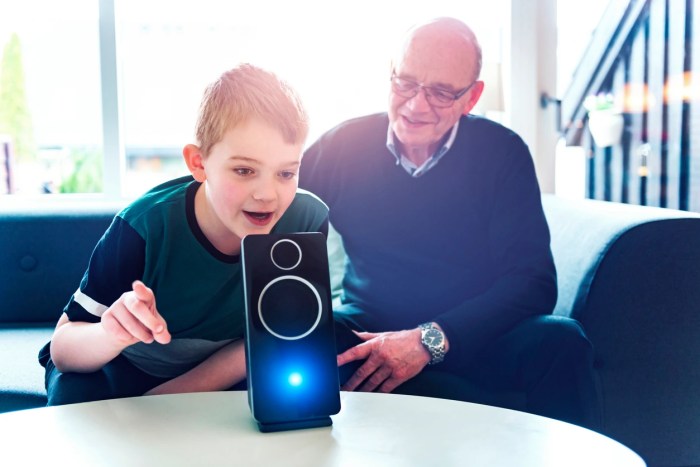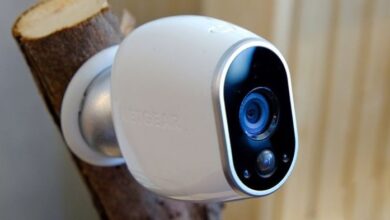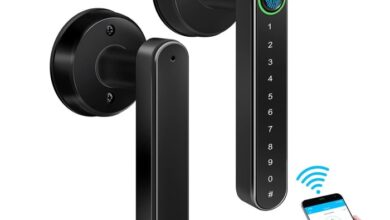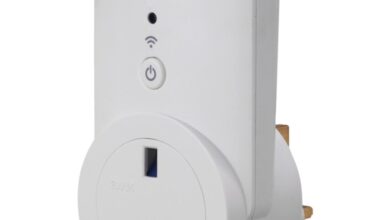Voice-Controlled Home The Future of Smart Living
Voice-Controlled Home: Imagine a world where your home anticipates your needs, responding to your voice with seamless precision. This isn’t science fiction; it’s the rapidly evolving reality of smart home technology. From adjusting the thermostat to locking the doors, voice control is transforming how we interact with our living spaces, offering unprecedented convenience and control. This deep dive explores the technology behind voice-controlled homes, its applications, user experience, challenges, and integration with other smart home systems, painting a comprehensive picture of this transformative technology.
We’ll dissect the core components of these systems, comparing leading voice assistants like Alexa, Google Assistant, and Siri, and examining the communication protocols that make it all work. We’ll also delve into the security and privacy implications, crucial considerations in an increasingly connected world. This isn’t just about convenience; it’s about building a smarter, safer, and more intuitive home environment.
Defining Voice-Controlled Home Systems
Voice-controlled home systems, also known as smart homes, represent a significant leap in home automation, seamlessly integrating technology into our daily lives. These systems offer convenience, efficiency, and enhanced security through voice commands, eliminating the need for manual control of various household devices. Their increasing popularity stems from the intuitive user experience and the potential for personalized automation scenarios.
Core Components of Voice-Controlled Home Systems
A typical voice-controlled home system comprises several key components working in concert. These include a voice assistant device (like a smart speaker or a smartphone app), a network connection (Wi-Fi or other suitable network), smart home hubs (often acting as central controllers), and various smart home devices (lighting, thermostats, appliances, security systems). The interplay between these components enables the user to control multiple devices with simple voice instructions.
For instance, saying “turn off the living room lights” triggers a chain of events: voice recognition, command processing, communication with the hub, and finally, the execution of the command by the smart light bulb. Robust system architecture is crucial for seamless operation and efficient resource management.
Types of Voice Assistants in Smart Homes
Several voice assistant platforms dominate the smart home market, each offering a unique set of features and capabilities. Amazon Alexa, Google Assistant, and Apple Siri are the most prominent examples. These platforms differ in their functionalities, the breadth of their device compatibility, and the specific features they offer. For instance, Alexa excels in its extensive library of skills, while Google Assistant often boasts superior natural language processing.
The choice of voice assistant often depends on the user’s existing ecosystem and personal preferences. The market also includes lesser-known platforms, which sometimes offer niche functionalities or integrations with specific smart home brands.
Communication Protocols in Voice-Controlled Home Automation
Effective communication between the various components of a voice-controlled home system is facilitated by specific communication protocols. These protocols ensure that devices can understand and respond to commands reliably and securely. Common protocols include Zigbee, Z-Wave, and Wi-Fi. Zigbee and Z-Wave are low-power, mesh networking protocols optimized for home automation, enabling communication between numerous devices with minimal energy consumption.
Wi-Fi, while less energy-efficient for many devices, provides a readily available and widely supported connection method. The choice of protocol often depends on the specific devices and their compatibility, as well as the network infrastructure available in the home. Secure communication is crucial to prevent unauthorized access and control of the system.
Comparison of Voice-Controlled Home System Architectures
Different architectures can be used to design voice-controlled home systems, each with its own strengths and weaknesses. A centralized architecture relies on a central hub to manage all devices and communications, offering simplicity in setup and management. However, a single point of failure can cripple the entire system. A decentralized architecture, in contrast, distributes control and communication, enhancing robustness and resilience.
However, this approach may introduce greater complexity in system configuration and management. Hybrid architectures combine elements of both approaches, aiming to balance the advantages of both centralized and decentralized systems. The optimal architecture depends on the scale and complexity of the smart home system, as well as the user’s technical expertise and tolerance for complexity.
Comparison of Popular Voice Assistant Platforms
| Platform | Features | Strengths | Weaknesses |
|---|---|---|---|
| Amazon Alexa | Smart home control, music streaming, voice shopping, skill integration, news updates | Large skill ecosystem, wide device compatibility, user-friendly interface | Privacy concerns, occasional connectivity issues, limited natural language understanding compared to some competitors |
| Google Assistant | Smart home control, music streaming, voice search, calendar management, task management | Superior natural language processing, tight integration with Google services, robust search capabilities | Less extensive skill ecosystem compared to Alexa, can be less intuitive for some users |
| Apple Siri | Smart home control (HomeKit), music streaming, messaging, reminders, call management | Strong focus on privacy, seamless integration within Apple ecosystem, excellent voice recognition in Apple devices | Limited third-party device compatibility, less extensive smart home integration compared to Alexa and Google Assistant |
Voice Control Applications in the Home
The integration of voice control into our homes is rapidly transforming how we interact with our environment, offering unprecedented convenience and efficiency. This shift from manual control to voice commands represents a significant leap forward in home automation, impacting everything from lighting and temperature to security and entertainment. Understanding the applications, benefits, and potential drawbacks is crucial for navigating this evolving technological landscape.
Voice control is no longer a futuristic fantasy; it’s a tangible reality reshaping daily routines. Imagine a world where your home anticipates your needs, reacting to your spoken requests with seamless precision. This isn’t science fiction; it’s the promise of a voice-controlled home, and the reality is already here for many. This section delves into the practical applications, advantages, and considerations surrounding this increasingly prevalent technology.
Common Household Tasks Controlled by Voice
Voice assistants empower users to manage numerous household tasks effortlessly. Simple commands can adjust lighting levels (“Alexa, dim the lights”), control the thermostat (“Hey Google, set the temperature to 72 degrees”), play music (“Siri, play my workout playlist”), and even start the coffee maker (“Okay Google, brew a pot of coffee”). Beyond these basic functions, more advanced systems allow for complex actions, such as locking doors (“Alexa, lock the front door”), setting timers (“Hey Google, set a timer for 15 minutes”), and making calls (“Siri, call Mom”).
The convenience extends to managing smart appliances, like washing machines and ovens, offering precise control over cycles and settings.
Benefits of Voice Control for Home Automation
The advantages of voice-controlled home automation are numerous and impactful. Firstly, convenience is paramount. Imagine controlling your entire home environment without lifting a finger – a boon for individuals with mobility limitations or busy lifestyles. Secondly, enhanced accessibility for individuals with disabilities is a significant benefit. Voice control offers a more intuitive and accessible way to interact with technology, removing physical barriers.
Thirdly, energy efficiency can be significantly improved through automated control of lighting and thermostats, optimizing energy consumption and reducing bills. Finally, improved home security is another key advantage. Voice commands can activate security systems, monitor activity, and alert residents to potential threats.
Security and Privacy Implications of Voice-Controlled Homes
While voice-controlled homes offer numerous advantages, security and privacy concerns are equally significant. The constant listening capabilities of voice assistants raise questions about data collection and potential misuse. Unauthorized access to personal information and the potential for eavesdropping are legitimate concerns. Furthermore, vulnerabilities in the system could allow malicious actors to gain control of smart home devices, potentially compromising security.
Addressing these concerns requires robust security protocols, encryption, and transparent data handling practices. Consumers should carefully consider the security features of voice assistants and smart home systems before adoption.
A Typical Day Using Voice Control in a Smart Home
Consider a typical day in a voice-controlled smart home: The day begins with a voice command to brew coffee and adjust the lighting to a gentler morning hue. During the day, the resident adjusts the thermostat remotely while commuting home, ensuring a comfortable temperature upon arrival. Evening brings voice-activated lighting adjustments, music streaming, and the locking of doors via voice command.
Throughout the day, the system passively monitors energy consumption, adjusting settings to optimize efficiency. This scenario showcases the seamless integration of voice control into daily life, offering unparalleled convenience and efficiency.
Potential Future Applications of Voice Control in Home Environments
Future applications of voice control in the home promise even greater integration and personalization. Imagine homes that anticipate your needs, proactively adjusting settings based on your routine and preferences. Predictive capabilities could automate tasks based on learned behavior, like adjusting lighting according to the time of day or preheating the oven based on your typical dinner schedule. The potential for personalized health monitoring, proactive home maintenance, and enhanced accessibility for elderly individuals is immense.
These advancements highlight the transformative potential of voice control in creating truly intelligent and responsive homes.
User Experience and Interface Design
Seamless integration of voice control into the home hinges on a positive user experience. A well-designed system anticipates user needs, responds accurately, and provides clear feedback, leading to increased adoption and satisfaction. Poorly designed systems, conversely, can lead to frustration and abandonment, highlighting the critical role of UX in the success of any voice-controlled home.
Natural Language Processing (NLP) is the engine driving the user experience. Its ability to accurately interpret spoken commands and translate them into actionable instructions is paramount. A system with robust NLP capabilities will understand a wider range of phrasing and accents, minimizing user errors and increasing the feeling of natural interaction. Conversely, a system with limited NLP understanding leads to frequent misunderstandings and a frustrating user experience, potentially making the user feel like they need to learn a specific “language” to control their home.
Factors Contributing to a Positive User Experience
Creating an intuitive and enjoyable voice interface requires careful consideration of several key factors. A smooth, quick response time is crucial; delays cause frustration. Clear and concise feedback, confirming the system’s understanding and execution of the command, builds user confidence. The system should also be adaptable to different user preferences and communication styles, offering customization options and learning user habits to anticipate their needs.
Finally, error handling is vital; a graceful response to an invalid command or unexpected error prevents negative user experiences.
Impact of Natural Language Processing on User Experience
The sophistication of the NLP engine directly influences user satisfaction. Advanced NLP enables the system to understand context, nuances, and colloquialisms, leading to a more natural and conversational interaction. This capability allows for more complex commands, such as “Turn on the living room lights and set the thermostat to 72 degrees,” executed without requiring multiple, separate commands. In contrast, a limited NLP system would likely require individual commands for each action, leading to a cumbersome and less intuitive experience.
Furthermore, the ability of the NLP engine to learn and adapt to individual users’ speech patterns and vocabulary enhances the personalization and ease of use.
Design Considerations for Intuitive Voice Interfaces
Designing an intuitive voice interface requires a focus on simplicity, clarity, and predictability. The vocabulary should be simple and consistent, avoiding jargon or technical terms. Feedback mechanisms should be clear and unambiguous, providing immediate confirmation of successful commands. The system’s responses should be tailored to the context of the user’s request, and the system should handle errors gracefully and informatively, offering suggestions or alternative methods if a command is misunderstood.
Furthermore, careful consideration should be given to the potential for ambiguous commands, designing the system to handle these situations effectively, perhaps by requesting clarification or offering choices.
Best Practices for Designing Voice User Interfaces (VUIs) for Home Automation
Designing effective VUIs requires a structured approach. The following best practices ensure a positive user experience:
- Prioritize simplicity and conciseness in commands and responses.
- Provide clear and immediate feedback on command execution.
- Implement robust error handling and provide helpful suggestions.
- Allow for user customization and personalization of settings.
- Design for diverse user needs and abilities, considering accents and speech patterns.
- Continuously test and iterate on the design based on user feedback.
Mock-up of a Voice-Controlled Home Interface
Imagine a sleek, minimalist interface displayed on a central touchscreen. The screen displays large, easily identifiable icons representing different rooms in the house (kitchen, living room, bedroom, etc.). Each room icon subtly glows when its corresponding devices are active. When a voice command is issued, a subtle animation around the relevant icon indicates the system is processing the request.
For example, if the user says, “Dim the lights in the living room,” the living room icon will pulse gently, and a small text message briefly appears below, confirming the action: “Living Room Lights: Dimmed.” If an error occurs, the icon might flash red, and a clear, concise error message would be displayed, offering possible solutions. The overall design prioritizes visual clarity and immediate feedback, creating a seamless and intuitive user experience.
The system learns user preferences over time, proactively adjusting settings based on established routines. For instance, if the user frequently sets the thermostat to a specific temperature at a certain time, the system might anticipate and preemptively adjust the temperature accordingly, providing a more proactive and user-friendly experience.
Technological Challenges and Limitations

The seemingly seamless integration of voice control into our homes masks a complex reality: significant technological hurdles remain before truly reliable and universally accessible systems become commonplace. Current limitations stem from a confluence of factors, ranging from the inherent difficulties of natural language processing to the practical challenges of ensuring consistent system performance across diverse home environments. Understanding these limitations is crucial for both developers and users to manage expectations and drive future innovation.
Voice recognition technology, while impressive in its advancements, still struggles in less-than-ideal acoustic conditions. The accuracy of voice commands degrades significantly in the presence of background noise, reverberation, or competing audio sources. This poses a considerable challenge in typical home environments, where sounds from televisions, music players, conversations, and household appliances can easily interfere with the accurate interpretation of voice commands.
Limitations of Voice Recognition in Noisy Environments
The core problem lies in the difficulty of isolating the user’s voice from background noise. Advanced algorithms employ techniques like noise cancellation and beamforming to enhance signal-to-noise ratio, but these methods are not foolproof. Consider a scenario where someone tries to adjust the thermostat while a television is playing loudly – the system might misinterpret the command or fail to register it entirely.
This highlights the need for more robust noise-reduction techniques and potentially, more sophisticated methods for disambiguating speech in complex acoustic settings. Research into techniques like deep learning and neural networks continues to improve accuracy, but complete robustness remains elusive.
Internet Connectivity and System Reliability Issues
Many voice-controlled home systems rely heavily on cloud-based services for processing and data storage. Interruptions in internet connectivity, therefore, can directly impact system functionality. A temporary outage might prevent a user from controlling their smart lights or receiving responses to voice commands. Furthermore, the reliability of the entire system depends on the stability of both the internet connection and the cloud-based services themselves.
System failures, server downtime, or software glitches can lead to frustrating user experiences and underscore the importance of developing systems with built-in redundancy and fault tolerance. For example, a system could be designed to function in offline mode for essential commands, offering a fallback option during internet disruptions.
Challenges of Integrating Voice Control with Smart Home Devices
Integrating voice control seamlessly across different smart home devices presents another set of complexities. Devices from various manufacturers often use different communication protocols and data formats, making it challenging to create a unified control system. Standardization efforts are underway, but the lack of universal interoperability remains a significant barrier to a truly seamless experience. Imagine attempting to control a smart lock from one vendor and a smart thermostat from another using a single voice command – the system might need to translate commands between different protocols, which can lead to delays or errors.
Moreover, ensuring security and privacy across diverse systems and platforms adds a further layer of complexity.
Handling Voice Ambiguity, Voice-Controlled Home
Voice commands are often inherently ambiguous. The same phrase can have multiple interpretations depending on context. For instance, the command “turn on the lights” could refer to all the lights in the house, or only those in a specific room. Different systems handle ambiguity using various techniques, including probabilistic models, natural language understanding (NLU), and contextual awareness.
More sophisticated systems employ machine learning algorithms to learn user preferences and improve the accuracy of interpreting ambiguous commands over time. However, completely eliminating ambiguity remains a challenge, requiring ongoing refinement of NLU techniques and user interaction design.
Error Handling and User Feedback
Effective error handling is crucial for a positive user experience. When a voice command is not understood or cannot be executed, the system should provide clear and informative feedback to the user. This might involve a simple verbal response like “I’m sorry, I didn’t understand that” or a more detailed explanation of the error. The system could also offer suggestions or alternative ways to achieve the desired outcome.
For instance, if the system fails to identify a specific device, it could prompt the user to provide a more precise description. In addition to verbal feedback, visual cues, such as on-screen messages or device indicators, can further enhance the user’s understanding of the system’s status. A well-designed error handling mechanism significantly improves user satisfaction and builds trust in the system’s reliability.
Integration with Other Smart Home Technologies
Voice control is rapidly transforming the smart home landscape, moving beyond simple commands to seamless integration with a multitude of devices and systems. This interconnectedness enhances convenience, efficiency, and overall user experience, creating a truly intelligent and responsive living environment. Understanding how voice control interacts with other smart home technologies is crucial to grasping its full potential.Voice control acts as a central nervous system for the smart home, unifying disparate systems under a single, intuitive interface.
Imagine controlling your lighting, security, thermostat, and entertainment systems all through simple voice commands. This integration simplifies complex tasks, allowing users to manage their home environment with ease and minimal effort. The key to this lies in the communication protocols and APIs that allow different devices and platforms to talk to each other.
Centralized vs. Decentralized Control Systems
The choice between a centralized and decentralized control system significantly impacts the integration and overall performance of a voice-controlled smart home. A centralized system uses a single hub or platform to manage all connected devices, offering streamlined control and simplified management. However, this approach creates a single point of failure; if the central hub malfunctions, the entire system could be compromised.
A decentralized system, on the other hand, distributes control across multiple devices or platforms, improving resilience but potentially complicating management and potentially reducing interoperability. Amazon Alexa and Google Home are examples of centralized systems, while systems relying solely on individual device APIs exemplify decentralized control. The optimal choice depends on the size and complexity of the smart home setup and the user’s technical expertise and tolerance for risk.
System Architecture Diagram
Imagine a diagram depicting a central voice control hub (e.g., Amazon Echo) at the center. From this hub, several lines extend to represent connections to various smart home components. One line connects to a smart lighting system, represented by a lightbulb icon. Another line connects to a security system, depicted by a camera icon. A third line connects to a smart thermostat, illustrated by a thermostat icon.
Finally, a line connects to a smart entertainment system, symbolized by a television icon. Each line represents a communication pathway, utilizing protocols like Zigbee, Z-Wave, or Wi-Fi to exchange data and commands between the voice control hub and individual devices. This illustrates the central role of the voice control hub in orchestrating the actions of various smart home components.
Interoperability Between Voice-Controlled Platforms
The ability of different voice-controlled platforms (e.g., Alexa, Google Assistant) to seamlessly communicate and work together is a significant challenge in the smart home industry. While some platforms offer limited interoperability through third-party integrations, true seamless integration remains a goal. A lack of standardization and proprietary protocols often hinder interoperability. However, advancements in open-source platforms and industry initiatives aim to improve compatibility and create a more unified smart home ecosystem.
For example, the Matter standard aims to address this fragmentation by providing a common communication language for smart home devices.
Examples of Enhanced Functionality
Voice control significantly enhances the functionality of existing smart home systems. For instance, imagine setting a scene with a simple voice command like “Alexa, set the mood for movie night.” This could simultaneously dim the lights, adjust the thermostat to a comfortable temperature, and start playing music on your smart speakers. Another example is enhancing security by verbally arming or disarming the security system, initiating a video feed from a smart camera, or receiving voice alerts about potential intrusions.
These scenarios demonstrate how voice control transcends individual device commands, creating automated sequences that enhance convenience, safety, and overall user experience. The potential for personalized automation, triggered by voice commands, represents a significant step toward a truly intuitive and responsive smart home.
Final Wrap-Up: Voice-Controlled Home
The journey into the world of voice-controlled homes reveals a technology brimming with potential, yet not without its hurdles. While challenges remain in areas like noise cancellation and system reliability, the advancements in natural language processing and interoperability are paving the way for a truly seamless and intuitive smart home experience. The convenience, personalized control, and enhanced security offered by voice-activated homes are undeniable, promising a future where technology seamlessly integrates into our daily lives, making them simpler, safer, and more enjoyable.
The future of home automation is here, and it’s talking.









